Experimental Study on the Physical Simulation of Water Invasion in Carbonate Gas Reservoirs
Abstract
:1. Introduction
2. Experimental Systems and Methods
2.1. Experimental Systems
2.2. Experimental Methods
3. Results and Discussion
3.1. Effect of Different Water Invasion Energies
3.2. Effect of Different Aquifer Sizes
3.3. Effect of Different Production Rates
3.4. Effect of Different Permeabilities
3.5. Effect of Different Fractures
4. Conclusions
Acknowledgments
Author Contributions
Conflicts of Interest
References
- Namani, M.; Asadollahi, M.; Haghighi, M. Investigation of water coning phenomenon in iranian carbonate fractured reservoirs. Adv. Biomed. Res. 2007, 1, 28–33. [Google Scholar]
- Ould-Amer, Y.; Chikh, S.; Naji, H. Attenuation of water coning using dual completion technology. J. Pet. Sci. Eng. 2004, 45, 109–122. [Google Scholar] [CrossRef]
- Shen, W.J.; Li, X.Z.; Liu, X.H.; Lu, J.L. Analytical comparisons of water coning in oil and gas reservoirs before and after water breakthrough. Electron. J. Geotech. Eng. 2014, 19, 6747–6756. [Google Scholar]
- Shen, W.J.; Liu, X.H.; Li, X.Z.; Lu, J.L. Water coning mechanism in Tarim fractured sandstone gas reservoirs. J. Cent. South Univ. 2015, 22, 344–349. [Google Scholar] [CrossRef]
- Jafari, I.; Jamshidi, S.; Masihi, M. Investigating the mechanism of water inflow in gas wells in fractured gas reservoirs and designing a controlling method. Int. J. Chem. Environ. Biol. Sci. 2012, 3, 482–487. [Google Scholar]
- Zendehboudi, S.; Elkamel, A.; Chatzis, I.; Ahmadi, M.I.; Bahadori, A.; Lohi, A. Estimation of breakthrough time for water coning in fractured systems: Experimental study and connectionist modeling. AIChE J. 2014, 60, 1905–1919. [Google Scholar] [CrossRef]
- Azim, R.A. Evaluation of water coning phenomenon in naturally fractured oil reservoirs. J. Pet. Explor. Prod. Technol. 2016, 6, 279–291. [Google Scholar] [CrossRef]
- Amooie, M.A.; Soltanian, M.R.; Xiong, F.; Dai, Z.; Moortgat, J. Mixing and spreading of multiphase fluids in heterogeneous bimodal porous media. Geomech. Geophys. Geo-Energy Geo-Resour. 2017, 1–20. [Google Scholar] [CrossRef]
- Meyer, H.I.; Garder, A.O. Mechanics of two immiscible fluids in porous media. J. Appl. Phys. 1954, 25, 1400–1406. [Google Scholar] [CrossRef]
- Blake, J.R.; Kueera, A. Coning in oils reservoirs. Math. Sci. 1988, 13, 36–47. [Google Scholar]
- Ahmed, T. Reservoir Engineering Handbook, 4th ed.; Gulf Professional Publishing, Imprint Elsevier: Oxford, UK, 2010. [Google Scholar]
- Muskat, M.; Wycokoff, R.D. An approximate theory of water-coning in oil production. Trans. AIME 1935, 114, 144–163. [Google Scholar] [CrossRef]
- Høyland, L.A.; Papatzacos, P.; Skjaeveland, S.M. Critical rate for water coning: Correlation and analytical solution. SPE Reserv. Eng. 1989, 4, 495–502. [Google Scholar] [CrossRef]
- Saad, E.D.S.; Darwich, T.; Asaad, Y. Water Coning in Fractured Basement Reservoirs. In Proceedings of the Middle East Oil Show, Manama, Bahrain, 11–14 March 1995. [Google Scholar]
- Bahrami, H.; Shadizadeh, S.R.; Goodarzniya, I. Numerical Simulation of Coning Phenomena in Naturally Fractured Reservoirs. In Proceedings of the 9th Iranian Chemical of Engineering Congress, Iran University of Science and Technology (IUST), Tehran, Iran, 23–25 November 2004. [Google Scholar]
- Cheng, K.H.; Jiang, T.W.; Wang, X.Y.; Mou, W.J.; Pan, Z.C. A study on water invasion mechanism of the bottom-water gas reservoir in the ordovician system of hetian-he gas field. Nat. Gas Ind. 2007, 27, 108–110. [Google Scholar]
- Hu, S.; Lin, Q.; Tang, J. Analysis method of aquifer behavior and water invasion performance partly trapped in heterogeneous gas reservoir. Nat. Gas Ind. 2004, 24, 78–81. [Google Scholar]
- Xiong, Y.; Yang, S.; Le, H.; Tang, J.; Yu, X. A new method of water influx performance analysis on fracture gas reservoirs with bottom water. Nat. Gas Ind. 2010, 30, 61–64. [Google Scholar]
- Perez, E.; Garza, F.R.D.L.; Samaniego-Verduzco, F. Water Coning in Naturally Fractured Carbonate Heavy Oil Reservoir—A Simulation Study. In Proceedings of the SPE Latin America and Caribbean Petroleum Engineering Conference, Mexico City, Mexico, 16–18 April 2012. [Google Scholar]
- Hu, Y.; Shao, Y.; Lu, Y.; Zhang, Y.F. Experimental study on occurrence models of water in pores and the influencing to the development of tight gas reservoir. Nat. Gas Geosci. 2011, 22, 176–181. [Google Scholar]
- Shen, W.J.; Li, X.Z.; Liu, X.H.; Lu, J.L.; Jiao, C.Y. Physical simulation of water influx mechanism in fractured gas reservoirs. J. Cent. South Univ. (Sci. Technol.) 2014, 45, 3283–3287. [Google Scholar]
- Jin, Z.H.; Johnson, S.E. Effects of elastic anisotropy on primary petroleum migration through buoyancy-driven crack propagation. Geomech. Geophys. Geo-Energy Geo-Resour. 2017, 1–14. [Google Scholar] [CrossRef]
- Fan, H.C.; Huang, Z.L.; Yuan, J.; Gao, G.; Tong, C.X. Solubility experiment of methane-rich gas and features of segregation and accumulation. J. Jilin Univ. (Earth Sci. Ed.) 2011, 41, 1033–1039. [Google Scholar]
- Perera, M.S.A.; Ranjith, P.G.; Choi, S.K.; Airey, D. Numerical simulation of gas flow through porous sandstone and its experimental validation. Fuel 2011, 90, 547–554. [Google Scholar] [CrossRef]
- Zou, C.N.; Du, J.H.; Xu, C.C.; Wang, Z.C.; Zhang, B.M.; Wei, G.Q; Wang, T.S.; Yao, G.S.; Deng, S.H.; Liu, J.J.; et al. Formation, distribution, resource potential and discovery of the Sinian-Cambrian giant gas field, Sichuan Basin, SW China. Pet. Explor. Dev. 2014, 41, 278–293. [Google Scholar] [CrossRef]
- Li, X.Z.; Gu, Z.H.; Wan, Y.J.; Liu, X.H.; Zhang, M.L.; Xie, W.R.; Su, Y.H.; Hu, Y.; Feng, J.W.; Yang, B.X.; et al. Geological characteristics and development strategies for Cambrian Longwanmiao Formation gas reservoir in Anyue gas field, Sichuan Basin, SW China. Pet. Explor. Dev. 2017, 44, 398–406. [Google Scholar] [CrossRef]
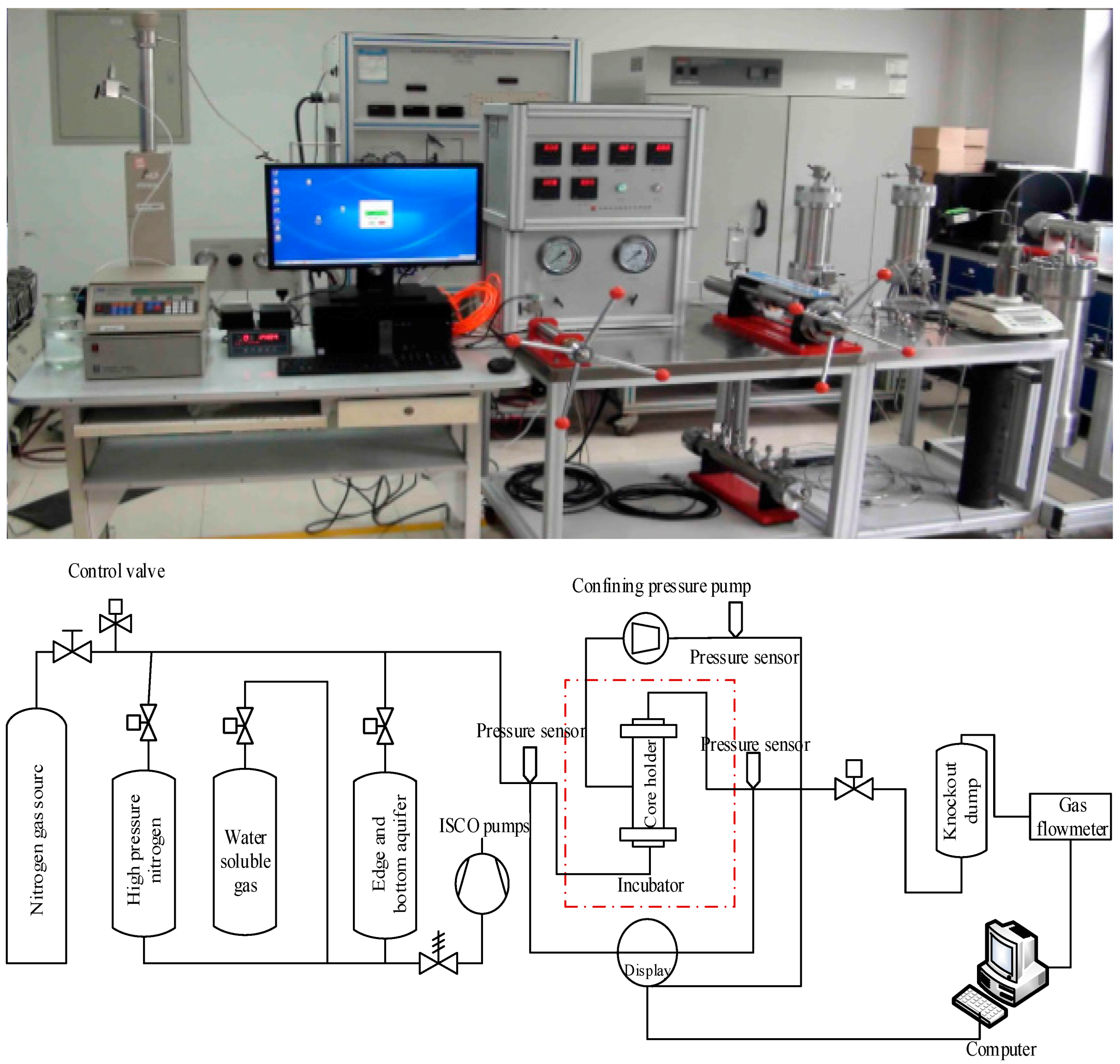


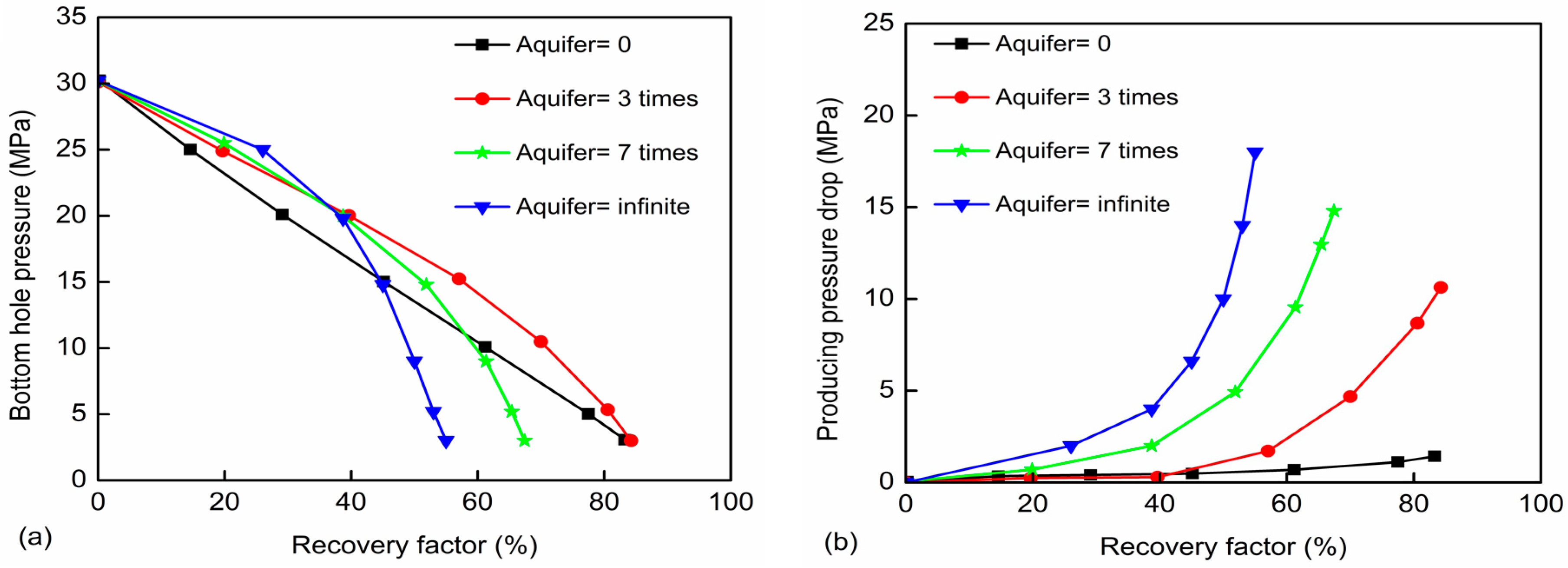

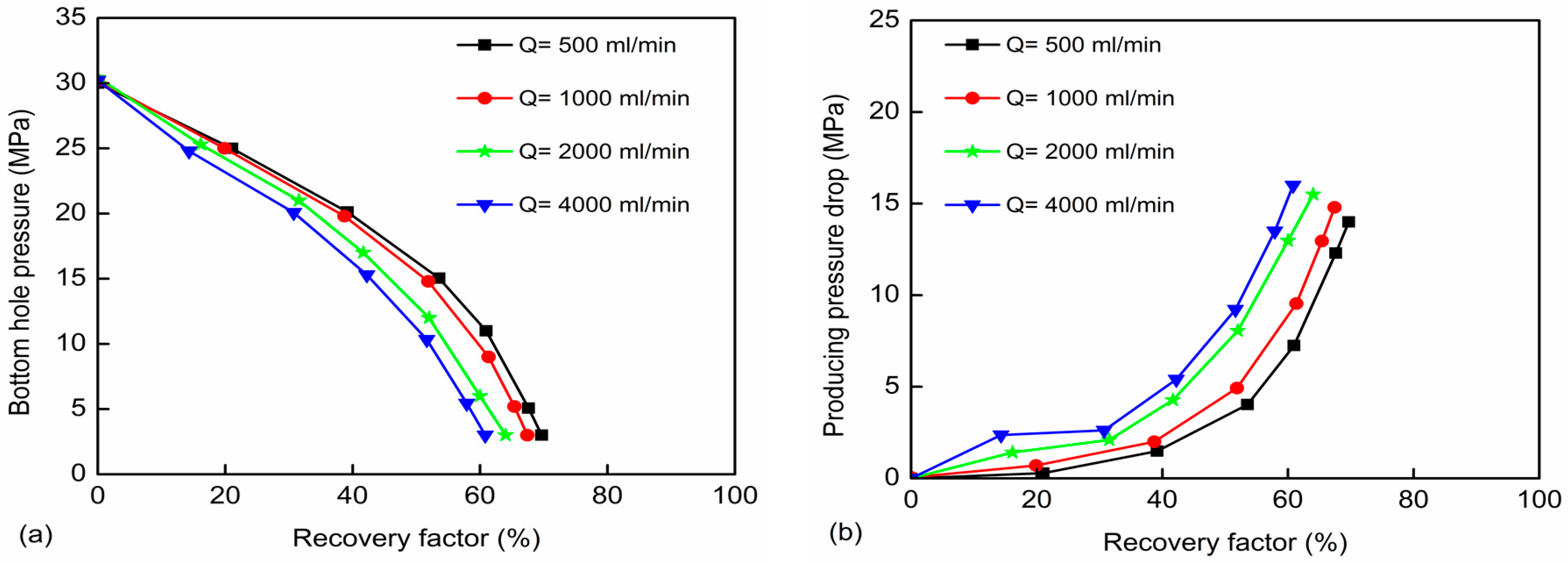
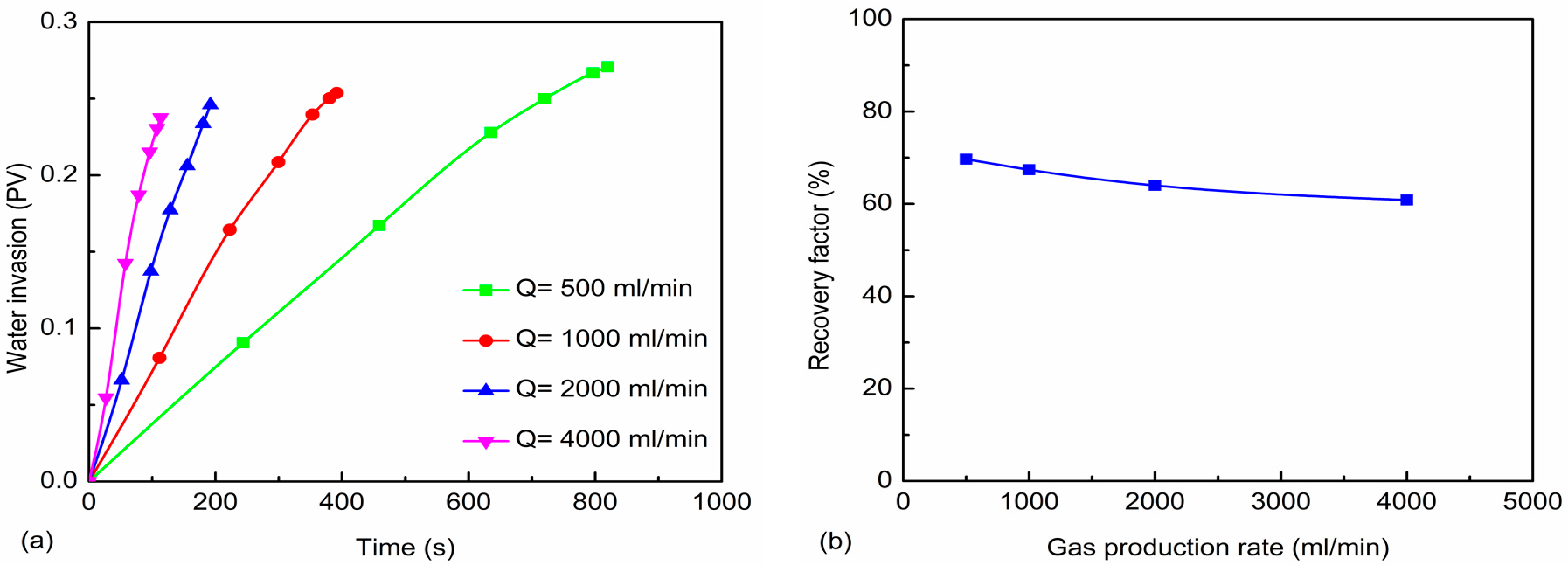

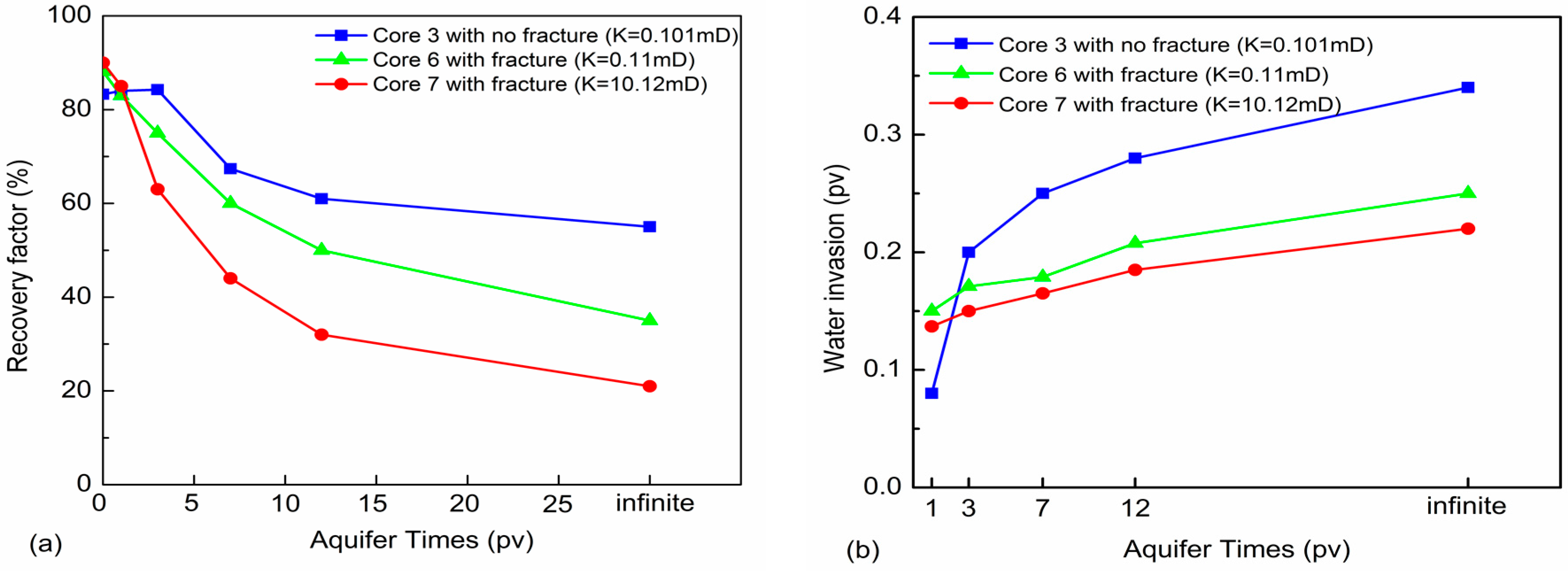

| NO. | Length (cm) | Diameter (cm) | Permeability (mD) | Porosity (%) |
|---|---|---|---|---|
| 1 | 10.105 | 10.438 | 0.001 | 4.10 |
| 2 | 9.807 | 10.021 | 0.021 | 4.30 |
| 3 | 10.156 | 10.440 | 0.101 | 5.10 |
| 4 | 10.350 | 10.159 | 1.010 | 8.80 |
| 5 | 10.153 | 10.357 | 15.310 | 10.60 |
| 6 | 10.255 | 10.257 | 0.110 | 5.30 |
| 7 | 10.250 | 10.257 | 10.120 | 5.40 |
| NO. | Fracture | Aquifer Size (Times) | Production Rate (mL/min) |
|---|---|---|---|
| 1 | no | 0, 3, 7, infinite | 500, 1000, 2000, 4000 |
| 2 | no | 0, 1, 3, 7, 12, infinite | 500, 1000, 2000, 4000 |
| 3 | no | 0, 3, 7, infinite | 500, 1000, 2000, 4000 |
| 4 | no | 0, 3, 7, infinite | 500, 1000, 2000, 4000 |
| 5 | no | 0, 3, 7, infinite | 500, 1000, 2000, 4000 |
| 6 | yes | 0, 3, 7, 12, infinite | 500, 1000, 2000, 4000 |
| 7 | yes | 0, 3, 7, 12, infinite | 500, 1000, 2000, 4000 |
© 2017 by the authors. Licensee MDPI, Basel, Switzerland. This article is an open access article distributed under the terms and conditions of the Creative Commons Attribution (CC BY) license (http://creativecommons.org/licenses/by/4.0/).
Share and Cite
Fang, F.; Shen, W.; Gao, S.; Liu, H.; Wang, Q.; Li, Y. Experimental Study on the Physical Simulation of Water Invasion in Carbonate Gas Reservoirs. Appl. Sci. 2017, 7, 697. https://doi.org/10.3390/app7070697
Fang F, Shen W, Gao S, Liu H, Wang Q, Li Y. Experimental Study on the Physical Simulation of Water Invasion in Carbonate Gas Reservoirs. Applied Sciences. 2017; 7(7):697. https://doi.org/10.3390/app7070697
Chicago/Turabian StyleFang, Feifei, Weijun Shen, Shusheng Gao, Huaxun Liu, Qingfu Wang, and Yang Li. 2017. "Experimental Study on the Physical Simulation of Water Invasion in Carbonate Gas Reservoirs" Applied Sciences 7, no. 7: 697. https://doi.org/10.3390/app7070697




